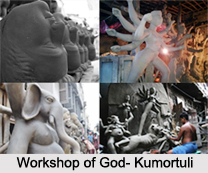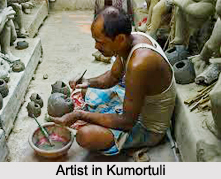 Kumortuli is a conventionally potters` quarter in northern Kolkata, located in West Bengal. Kumortuli is a place by virtue of their artistic productions these potters have moved from obscurity to prominence. Kumortuli is one of the seven wonders in Kolkata. The narrow maze of lanes and alleyways dictate with humanity, and gods and goddesses in various states of creation. Wandering through them, and seeing the artists at work, reveals a fascinating world within a world right in front of one.
Kumortuli is a conventionally potters` quarter in northern Kolkata, located in West Bengal. Kumortuli is a place by virtue of their artistic productions these potters have moved from obscurity to prominence. Kumortuli is one of the seven wonders in Kolkata. The narrow maze of lanes and alleyways dictate with humanity, and gods and goddesses in various states of creation. Wandering through them, and seeing the artists at work, reveals a fascinating world within a world right in front of one.
Location of Kumortuli
Kumortuli is located at Ward No. 9 of Kolkata Municipal Corporation, mostly between Rabindra Sarani and the Hooghly River. Kumortuli is between Ahiritola and Shobhabazar.
History of Kumortuli
Kumortuli is a place where the British colonisation of West Bengal and India started following the victory of the British East India Company in the Battle of Plassey in 1757. The British East India Company decided to build new settlement Fort William at the site of the Gobindapur village. Most of the existing population shifted to Sutanuti, Kalikata and Govindapur. The villages of Gobindapur, Sutanuti and Kalikata developed to give rise to the later day metropolis of Kolkata.
Artisan`s settlement of Kumortuli
Kumortuli is an artistic place where most of the artisans living in the north Kolkata dwindled in numbers or even vanished, as they were pushed out of the area in the late nineteenth century by the invasion from Burrabazar. In addition, the Marwari businessmen virtually flushed out others from many north Kolkata localities. Gradually they took to making the images of gods and goddesses, worshipped in large numbers in the mansions all around and later at community pujas in the city and beyond.
 Condition of Kumortuli
Condition of Kumortuli
In Kolkata, the icon-artisans mostly dwell in poor living conditions. The more popular artisians are Mohan Banshi Rudra Pal and his sons Sanatan Rudra Pal and Pradip Rudra Pal, Rakhal Pal, Ganesh Pal, Aloke Sen, Kartik Pal, Kena Pal, who are still reigning figures of Kumortuli and despite the threats from the "theme artists", they are booked by major puja organisers who admire the old school. Women are not lagging behind. Kumortuli boasts of the presence of some 30 odd women-artisans, like Minati Pal, Soma Pal, Kanchi Pal and Chapa Rani Pal. They have been in the business of idol making for a long time. The Durga Puja of Kumartuli dates back to 1933.



















